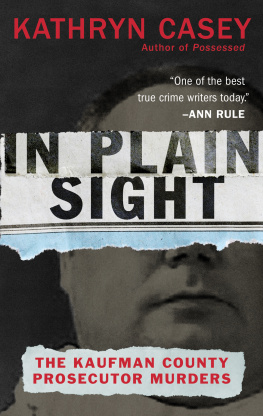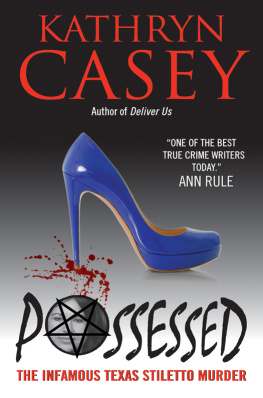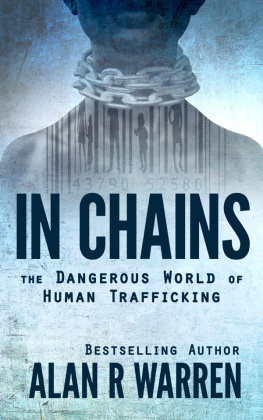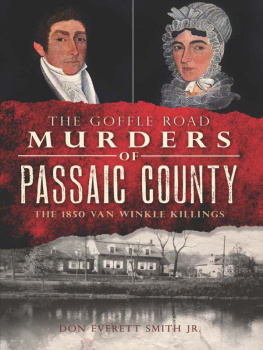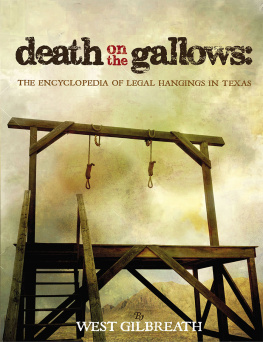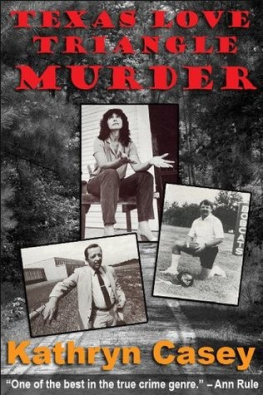Contents
For all the victims of violence and the good people
who work hard to keep us safe.
You ended up with men who developed grudges. They became vengeful. Neither one would let it go.
Sandra Harward
I love Kathryn Caseyalways smart, always scary, and always pitch-perfect on Texas true-crime.
Ron Franscell, bestselling author of The Darkest Night and Morgue: A Life in Death
Going deeper than anyone has before, Kathryn Casey transforms solid research on the Texas prosecutor murders into a deft and compelling crime narrative. In the style of Ann Rule, she honors the victims, while also building a fully-realized villain. Bristling with intrigue, In Plain Sight takes us into the minds of justice officials who must identify and catch the person targeting them before more of them are killed.
Katherine Ramsland, bestselling author of Confession of a Serial Killer: The Untold Story of Dennis Rader, the BTK Killer
In Plain Sight, Kathryn Caseys exploration of a small-town good citizen turned vengeful killer, is told with such creeping suspense that it reads like a crime novel. But the fact that its real makes it far more chilling, a vivid and even horrifying exploration of the making of a murderer.
Deborah Blum, Pulitzer Prizewinning author of The Poisoners Handbook: Murder and the Birth of Forensic Medicine in Jazz-Age New York
Dear Readers:
When I began researching this book in late 2014, I was told that I would never get interviews with either Eric or Kim Williams. They arent talking to anyone, their gatekeeper told me. I wasnt surprised. Id already heard that Kim and Eric had turned down requests from major newspapers, along with 48 Hours and DatelineNBC.
I was pleased then when, days later, the woman e-mailed me: Eric and Kim have both agreed.
Over the next eighteen months, I had a series of in-person meetings with Eric and Kim, the couple at the center of three of the most notorious murders of this century. That access proved invaluable. Sections of the book where conversations between Eric and Kim are depicted are based on my interviews with Kim, testimony, and evidence presented at trial.
The result is In Plain Sight, a look behind the headlines at how the terror that mesmerized the world unfolded in Kaufman County, Texas, in the spring of 2013.
Kathryn Casey
2017
Contents
Guide
T he parking lot at the Terrell ISD Performing Arts Center gradually emptied after the memorial service. Throughout the event, officers guarded the entrances and exits, patrolled from the roof with binoculars and snipers rifles. But once the tributes ended and the guests departed, the sentries packed to leave. Only a few lingered, perhaps pondering the unlikely turn of events: The man theyd gathered to honora well-known prosecutorhad been mercilessly gunned down in broad daylight in the small city of Kaufman, Texas.
Who would do such a thing? Murdering an assistant DA declared war on law enforcement. In response, local, state, and national agencies flooded the town, including Texas Rangers, ATF, and FBI agents.
While investigators refused to disclose theories, intense nationwide coverage in newspapers and on TV proposed possibilities. Some pundits labeled the assassination the likely work of the powerful prison group dubbed the Aryan Brotherhood of Texas. Others noted similarities to executions of officials south of the border and speculated that the murder could be the work of the Mexican cartel.
While stragglers slowly pulled away from the parking lot, inside the building the nearly deserted auditorium remained set for the memorial service. A somber curtain hung behind the stage. Between two pillars bearing sprays of red-and-white flowers, a table held a framed photograph of the dead man, Mark Hasse, his brown hair combed to the side, wearing glasses and a crewneck sweater.
In the cavernous room, two men remained behind, seated side by side on the stage and dangling their legs over the edge. Mike McLelland, a round, bulky man in a dark suit, was Marks boss and Kaufman Countys district attorney. His thick salt-and-pepper hair combed back, his mustache nearing white, McLelland had a booming presence that commanded attention. An exarmy major, on that day he felt the anguish of losing one of his men. Earlier, hed delivered an emotional eulogy, telling stories about Hasse, a man he considered a friend.
Now, however, McLelland practically whispered to Mike Burns, a district attorney from a nearby county. If others remained in the theater, McLelland didnt want them to overhear.
There are people trying to make names on this investigation, Mike McLelland charged, bitterness resonating in his voice. Bringing up the headlines about drug cartels and prison gangs, the rotund DA looked at Burns with a resolute gaze. This case is local. The killer is somebody bent on revenge. For a moment he paused, perhaps considering what hed say next. This is somebody really close to home.
M eanwhile, in a one-story brick house less than two miles from the murder scene, a dough-faced man with dimples, who looked younger than his forty-five years, smiled. On his computer, Eric Williams clicked between competing news reports of the memorial service. Perhaps he felt a swell of pride. More than a week had lapsed, and the massive law enforcement response hadnt connected the dots. Hadnt figured it out.
It appeared hed pulled off the perfect murder.
Watching the memorial unfold on television, at times he chuckled. How he must have enjoyed that those investigating Hasses murder had veered off course. How superior he must have felt.
They all had much yet to understand: the most important thingthe killing wasnt over.
Growing up, Eric was the golden boy.
Tera Williams Bellemare
M any believe the eyes are windows into the soul, but is there any way to truly look inside a heart? Perhaps the task becomes even more complicated when fantasy takes over. Such an incongruous combination: a happy disposition, an engaging smile, an almost childlike appearance, and festering wrath.
On the surface, little about Eric Williamss upbringing appeared remarkable. For the most part, he could have been any boy raised in rural America, surrounded by loving parents, a younger sister, and a tight group of friends.
One of eleven children, Erics father, Jim, grew up in a family of sharecroppers in Alvin, Texas. Jim was like the rest of us, he quit school to work. No one went to college, said one of his sisters. At seventeen, Jim joined the marines and served as a machinist in Korea. Once home, he met Jessie Ruth Lyles at a square dance. After a brief courtship, they married, and in April 1967, their first child arrived three weeks early. For a middle name, Jessie Ruth dropped the final letter from her maiden name, and he became Eric Lyle Williams.
As a young child, Eric had his fathers wide smile. Following the style at the time, Jessie emulated the clothing Jackie Kennedy had favored for her baby boy, and sewed Eric John-John coveralls. Bright and inquisitive, Eric entertained himself, rarely crying for attention. Were not people given to a lot of emotion, Jim said. We dont show a lot.
Instead, the Williamses appeared strong and proud. Jessie Ruth had a matter-of-fact manner, and on those occasions when she became emotional, she squared her shoulders and forged on, fighting down her feelings. Describing her own family, shed say, Just good people who kept on working without expecting something from somebody.
In their home, Jim and Jessie taught the importance of civic duty. They believed that those who didnt vote relinquished their right to complain. They volunteered during elections and stressed the importance of military service. In stature a small man, just five-foot-seven and wiry, Jim relied on his marine training to gain a job in a lab that built instruments for student projects at Fort Worths Texas Christian University. On weekends, his beard carefully manicured, he dressed as a Confederate soldier to participate in Civil War reenactments.
Next page
